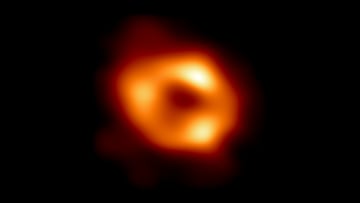Why is the Milky Way black hole called Sagittarius A*?
The latest scientific discovery about our galaxy has revealed a supermassive black hole as its centre thanks to the Event Horizon Telescope.


Earlier this week, excited scientists published their images of the second black hole ever caught on camera, Sagittarius A*, also known as Sgr A*. Spanish investigator José Luis Gómez, who was involved in finally nailing down the photograph, published a column in Spanish newspaper El País where he explained the reasoning behind the name.
“This is “our” black hole, a cosmic giant that contains four million suns and is located about 26,000 light-years away from us, in the constellation of Sagittarius, for which it gets its nickname Sagittarius A*, or SgrA * as it is known among friends,” Luis Gómez explained.
The Latin name for archer, the Sagittarius constellation is one of the oldest recognised constellations, noted by 2nd-century astronomer Ptolemy as well as being recognised by the ancient Sumerian culture. It is in this constellation that the Milky Way, our galaxy, resides. Ergo, Luis Gómez’s description of “our” black hole makes further sense in this context; both the black hole and our planet reside in the same area of space.
Astronomers are very excited today about the release of the first image of the black hole at the center of our galaxy. I just want you to not be confused about something.
— Hank Green (@hankgreen) May 12, 2022
It’s called “Sagittarius A*” which is pronounced “Sagittarius A star.” But it is not a star! pic.twitter.com/FD8AbjQZQ2
Confusingly, the ‘*’ in the name does not allude to anything to do with stars in an interstellar context. If there was a symbol on a keyboard for a black hole that would be useful, or maybe in future scientists will add emojis to their naming conventions.
Why is the discovery significant?
Related stories
Sagittarius A* is a huge supermassive black hole at the Galactic Centre of the Milky Way, with a mass equivalent to that of four million suns. The EHT project has been attempting to directly observe the immediate environment of a black hole, which could lead to advances in the study of general relativity and prove the existence of event horizons.
This is what the centre of our Milky Way ACTUALLY looks like 🤯
— BBC Earth (@BBCEarth) May 12, 2022
This the first ever photo of Sagittarius A*, the supermassive black hole at the centre of our galaxy. But how on Earth do you photograph a black hole? #BlackHole pic.twitter.com/3IVJx99eaG
Sgr A* is the second black hole the team has successfully pictured. In April 2019, the EHT Collaboration released the first ever image of a black hole, M87*, located at the centre of the Messier 87 galaxy, some 55 million light years from Earth. More than a thousand times bigger and more massive than Sgr A*, M87* was easier to photograph as the speed of Sgr A* was such that taking a photo using conventional methods proved impossible.

